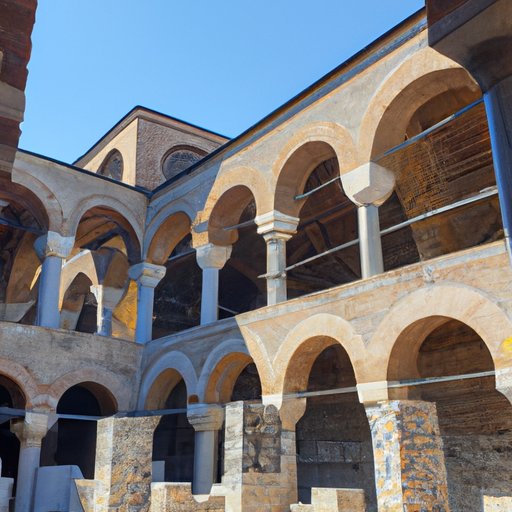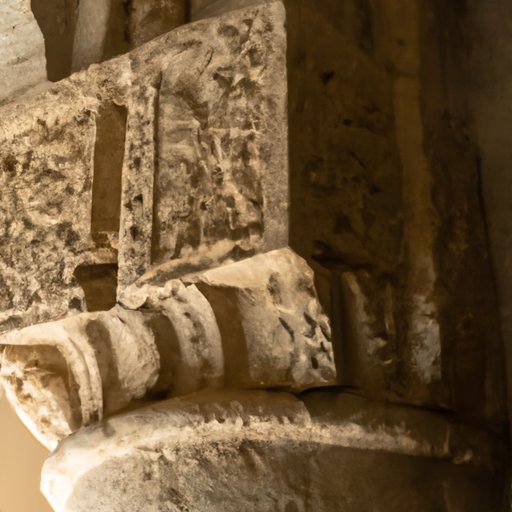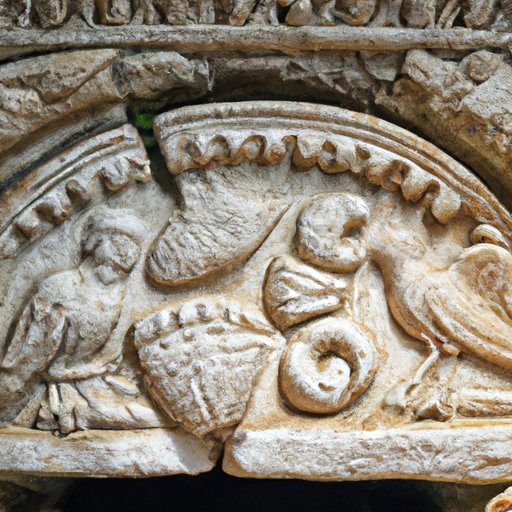Introduction
Byzantine art and architecture is a term used to describe the visual arts created in the Eastern Roman Empire during the period from the 4th to 15th centuries. This period saw the emergence of a distinctive style of artwork and architecture that was heavily influenced by the spread of Christianity throughout the region. In this article, we will explore the different factors that contributed to the development of Byzantine art and architecture throughout its history.

Historical Overview of Byzantine Art and Architecture
The Byzantine Empire was founded by Constantine I in 330 AD when he moved the capital of the Roman Empire from Rome to the city of Byzantium, which he renamed Constantinople. The Byzantine Empire lasted until 1453, when it was conquered by the Ottoman Turks. During this time, the Byzantine Empire experienced a period of great artistic and architectural achievement.
The spread of Christianity had a profound effect on the development of Byzantine art and architecture. By the 6th century, Christianity had become the official religion of the Byzantine Empire and had a large influence on the culture and art of the region. Churches and monasteries were built throughout the empire and these were decorated with intricate mosaics, frescoes, and sculptures.
The development of Byzantine art and architecture was also heavily influenced by the expansion of trade routes in the region. Merchants from all over the world traveled through the Byzantine Empire, bringing with them goods and ideas from other cultures. This led to the use of imported materials such as marble, glass, and precious stones in Byzantine art and architecture.

The Impact of Christianity on Byzantine Art and Architecture
The spread of Christianity had a significant impact on Byzantine art and architecture. One of the most important aspects of Christian art was iconography, or the use of symbols and images to represent religious figures and concepts. This was used extensively in Byzantine art and architecture, with scenes from the Bible often depicted in churches and mosaics. Many of these symbols and images have become iconic in the Christian faith today.
Christianity also had a major influence on the design of Byzantine architecture. Churches and monasteries were designed to reflect the teachings of the faith, with many featuring domes, arches, and other features that symbolized the divine power of God. Furthermore, the use of icons and images in architecture was used to convey religious messages to those who entered the building.

How Trade and Commerce Shaped Byzantine Art and Architecture
The expansion of trade routes in the Byzantine Empire played a major role in the development of Byzantine art and architecture. Merchants from around the world brought with them goods and ideas that were incorporated into Byzantine art and architecture. This included the use of imported materials such as marble, glass, and precious stones, which were used to create stunning works of art and architecture.
The use of imported materials also allowed for the creation of larger and more ambitious projects. For example, the Hagia Sophia in Istanbul was built using large quantities of imported marble and glass. The use of these materials allowed for the construction of a grandiose structure that was unlike anything seen before in the region.
The Role of Imperial Power in the Development of Byzantine Art and Architecture
The Byzantine Empire was ruled by an Emperor and this imperial power had a significant influence on the development of Byzantine art and architecture. The Emperor was seen as a representative of God on earth and this was reflected in the art and architecture of the period. Images of the Emperor often featured prominently in churches and mosaics, while imperial ideology was promoted through the decoration of public buildings.
Imperial patronage was also used to support the creation of works of art and architecture. Wealthy patrons would commission works of art and architecture to be displayed in their homes and churches, while the Emperor would provide funds to support artists and architects. This patronage allowed for the creation of some of the most impressive works of art and architecture seen in the Byzantine Empire.
The Influence of Ancient Greek and Roman Art on Byzantine Art and Architecture
The Byzantine Empire was heavily influenced by the art and architecture of the Ancient Greeks and Romans. Artists and architects studied the classical models of the past and adapted these techniques and styles to create new works of art and architecture. This included the use of columns, statues, and other elements that were inspired by the classical period.
The influence of Ancient Greek and Roman art can be seen in the designs of many of the most famous Byzantine structures, such as the Hagia Sophia in Istanbul. This building features a dome, which was inspired by the Pantheon in Rome, and a series of columns which were modeled after those found in the Temple of Athena in Athens.
The Role of Patronage in the Creation of Byzantine Art and Architecture
Patronage was an important factor in the development of Byzantine art and architecture. The Emperor was the most important patron in the Byzantine Empire and he used his wealth and power to support the creation of works of art and architecture. Wealthy patrons also commissioned works of art and architecture to be displayed in their homes and churches.
The use of patronage allowed for the creation of some of the most impressive works of art and architecture seen in the Byzantine Empire. These works were often created to glorify the Emperor and promote imperial ideologies, but they also served to inspire awe and admiration amongst visitors.
Conclusion
The development of Byzantine art and architecture was heavily influenced by the spread of Christianity, the expansion of trade routes, imperial power, and the influence of Ancient Greek and Roman art. Furthermore, patronage played an important role in the creation of stunning works of art and architecture. Today, the legacy of Byzantine art and architecture can still be seen in many parts of the world and it remains an important part of our cultural heritage.
(Note: Is this article not meeting your expectations? Do you have knowledge or insights to share? Unlock new opportunities and expand your reach by joining our authors team. Click Registration to join us and share your expertise with our readers.)
